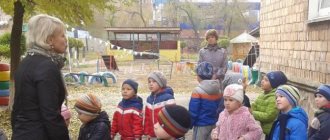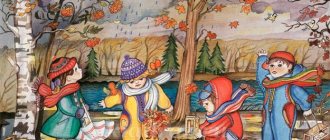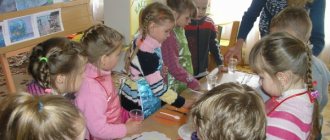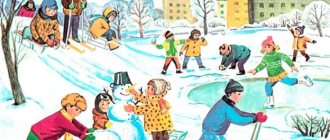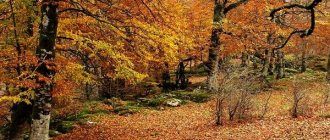Card file of autumn walks (senior group)
November.Card No. 5
1.Observation of rowan
Target:
consolidate knowledge about the benefits rowan brings to animals and birds in the cold season.
Progress of observation
So the first frost caught the rowan berries, they became tasty and soft. Animals and birds love rowan. A bear, if he finds it in the forest, hung with bunches of berries, will deftly tilt the flexible tree and enjoy its fruits with pleasure; The forest giants, elk, also like rowan berries. They reach the very top of the tree and eat fruits and branches with appetite. Berries that fall to the ground are picked up by voles, hedgehogs, chipmunks and squirrels. On pre-winter November days, flocks of bullfinches and waxwings arrive. They stick around the rowan and peck its juicy sweet berries. The birds peck quickly, dropping a lot of berries on the ground, then fly away further. Rowan saves many birds from hunger.
The crane's cry has already sounded, The garden has long since crumbled, And the bright clusters of rowan berries are still burning, hanging down.
2. “Sand cone” experiment.
Target:
show the property of sand - flowability.
Material: sand.
Procedure: Take a handful of dry sand and release it in a stream so that it falls in one place.
Gradually, a cone forms at the site of the fall, growing in height and occupying an increasingly larger area at the base. If you pour sand for a long time, first in one place, then in another, drifts occur; the movement of sand is similar to a current.
Conclusion: the property of sand is flowability.
3. Outdoor games
"Planes", "Sparrows and the Cat".
Target:
teach to quickly perform movements at the teacher’s signal and run in the indicated direction; cultivate friendliness.
4.Individual work
"Get in the basket."
Target:
develop accuracy and eye.
5. Didactic game
"Hide and Seek"
Target:
learn to find a tree by description, consolidate the ability to use prepositions in speech: behind, about, before, next to, because of, between, on; develop auditory attention.
6.Independent motor activity
November.
Card No. 5. Evening walk
1. Observation of migratory birds
Target:
expand ideas about migratory birds, about the changes in the life of birds in the fall, when cold weather sets in; foster love and care for birds.
The waters rustled like a fast stream, Birds flew away to warmer lands.
The teacher asks the children questions: What birds fly to warmer climes? Why are they doing that?
Birds gather in flocks and fly low above the ground. This means that they will soon fly away to warmer climes. Swallows will be the first to do this, since with the onset of cold weather the insects they catch in flight disappear. The last to fly away are ducks, geese, and cranes, as water bodies begin to freeze and they cannot find food in the water.
The teacher invites the children to complete the sentence:
• The sparrow is small, and the crane... (big).
• The duck is gray, and the swan... (white).
2. Didactic game “What kind of bird is this?”
Target:
clarify and expand ideas about bird life in autumn; describe birds by their characteristic features; cultivate a caring attitude towards birds.
Progress of the game:
Children are divided into 2 subgroups. Children of one subgroup describe the bird, and the other have to guess what kind of bird it is. You can use riddles. Then another subgroup asks their questions.
3. Word game “Do you remember these poems?”
Goal
: development of memory, attention, speech activity.
Progress of the game:
the teacher reads excerpts from poems familiar to the children. Children must pronounce the missing words.
Where did the sparrow have lunch? Don't stand too close:
At the zoo there are... (animals). I (tiger cub)
but not (…).
Wind across the sea (...)
And (...) customizes. Etc.
4. Outdoor game “Sparrows”. Target:
activation of the sound [h] in onomatopoeia;
development of dexterity. Progress of the game:
Children (sparrows) sit on a bench (in nests) and sleep. In response to the teacher’s words: “Sparrows live in a nest and everyone gets up early in the morning,” the children open their eyes and say loudly: “Tweet-chik-chik, chirp-chik-chik! They sing so joyfully."
After these words, the children scatter around the area. To the words of the teacher: “They flew to the nest!” - return to their places.
Labor activity:
Collecting pebbles on the site.
Target:
develop the ability to notice cleanliness in the area.
Organization and methodology for conducting walks in the senior group in accordance with the State Regulations
Tatiana Zhuravel
Organization and methodology for conducting walks in the senior group in accordance with the State Regulations
Organization and methodology of walks
in the senior group in accordance with the State Standard of Education
Prepared by: Zhuravel. I., manager
MDOU "NURSERY-GARDEN No. 180 DONETSK"
Children's stay in the fresh air is of great importance for the physical development of a preschooler. Walking is the first and most accessible means of hardening a child's body . It helps to increase its endurance and resistance to adverse environmental influences, especially colds.
During the walk, children play and move a lot. Movement increases metabolism, blood circulation, gas exchange, and improves appetite. Children learn to overcome various obstacles, become more agile, dexterous, courageous, and resilient. They develop motor skills and abilities, strengthen the muscular system, and increase vitality.
A walk is a mandatory element of the daily routine.
The main task of the pedagogical work of a teacher during a walk is to ensure
– active,
– meaningful,
– varied,
- activities that are interesting for children.
Properly organized and thoughtful walks help to achieve the goals of the comprehensive development of children.
During the walk, educational tasks should be fully realized:
– Children’s health.
- Physical development.
– Development of independence.
– Broadening your horizons.
– Familiarization with the surrounding world.
– Education of aesthetic feelings, culture of behavior.
In order to successfully implement the above tasks, careful long-term planning of this critical moment is necessary. When planning a walk, the teacher must take into account many different factors:
- weather;
– age and number of children;
– availability of inventory and related equipment ;
– previous group classes and much more .
Requirements for the duration of the walk . Duration of outdoor walks .
Approximately two to three hours a day are allotted for children to spend time in the fresh air. The time allotted for walks must be strictly observed.
– In winter, outdoor walks are carried out 2 times a day : in the first half of the day - before lunch, in the second half of the day - before the children go home. In order to prevent hypothermia of body parts (face, arms, legs)
in cold weather, it is recommended to send children into a heated vestibule for heating for no more than 5-7 minutes.
Winter walks in kindergarten for children 5-7 years old are held at temperatures down to – 15°C.
– The time for each age group to go for a walk is determined by the mode of education and training. Walking prohibited due to wind force exceeding 15 m/s.
Requirements for the equipment and sanitary condition of the kindergarten site for walks .
area, planned and equipped accordance is of great importance It is desirable that each age group has a separate area, fenced off from other groups by bushes . In this area, places are allocated for outdoor games and the development of children’s movements (a flat area, for playing with sand, water, building materials, for creative games and games with various toys.
The site should have equipment for the development of movements: climbing fences (triangular, tetrahedral and hexagonal, a log for balance exercises, a slide, equipment for jumping and throwing exercises. All this should have an attractive appearance, be durable, well processed, secured and correspond to the age and strength of the children.In addition to permanent equipment, toys and aids are brought to the site in accordance with the planned work plan.
In addition to playgrounds, the site must have closed gazebos for protection from rain and sun. In dry and hot weather, watering the area and sand is done at least 2 times a day. Cleaning of the territory of the site is carried out by teachers , assistant teachers, and a janitor every day: in the morning before the children arrive and as the territory becomes dirty. At the entrance to the building there should be gratings, scrapers, mats, and brushes. In winter, a slide, ice paths and snow structures, and a skating rink (if conditions permit)
.
Walk structure :
1. Observation.
2. Outdoor games: 2-3 games of high mobility, 2-3 games of low and medium mobility, games of children’s choice, didactic games.
3. Individual work with children on the development of movements and physical qualities.
4. Children's labor on the site.
5. Independent play activity.
Observation.
A large part of the walks is devoted to observations (pre-planned)
behind natural phenomena and social life.
Observations can be carried out with a whole group of children , with subgroups , as well as with individual children.
At older ages, observations should range from 15 to 25 minutes. They should be carried out daily , but each time children should be offered different objects to consider.
Objects of observation can be:
•Wildlife: plants and animals;
•Inanimate nature: seasonal changes and various natural phenomena (rain, snow, flowing streams)
;
• Adult labor.
Observations of the work of adults (janitor, driver, builder, etc.)
are organized 1-2 times a quarter .
Types of observation:
• Short-term observations are organized to formulate information about the properties and qualities of an object or phenomenon (children learn to distinguish shape, color, size, spatial arrangement of parts and the nature of the surface, and when familiarizing themselves with animals, characteristic movements, sounds made, etc.
• Long-term observations are organized to accumulate knowledge about the growth and development of plants and animals, and seasonal changes in nature. Children compare the observed state of the object with what was before.
When organizing observations , the teacher must always follow this sequence:
1. facts are established;
2. connections are formed between parts of the object;
3. children’s ideas are accumulating;
4. comparisons are being made;
5. conclusions are drawn and connections are made between being carried out now and those carried out earlier .
The surrounding life and nature provide an opportunity to organize interesting and varied observations.
Outdoor games.
The leading place during the walk is given to games , mainly active ones. They develop basic movements, relieve mental stress from classes, and develop moral qualities.
The choice of game depends on the time of year, weather, air temperature. On cold days, it is advisable to start your walk with games of greater mobility associated with running, throwing, and jumping. Fun and exciting games help children cope better with cold weather. In damp, rainy weather (especially in spring and autumn)
Sedentary games that do not require a lot of space
should Games with jumping, running, throwing, and balance exercises should be carried out on warm spring, summer days and early autumn.
During walks , plotless folk games with objects, such as grandmothers, ring throws, skittles, can be widely used, and in older groups, elements of sports games: volleyball, basketball, gorodki, badminton, table tennis, football, hockey. In hot weather, water games are played .
Time for outdoor games and physical exercises during a morning walk : in older groups – 20-25 minutes . On an evening walk, 12-15 minutes .
Every month, learn 2-3 exercises (repeat within a month and consolidate 3-4 times a year)
.
In the senior group, relay races , sports games, and games with elements of competition are held.
Outdoor games end with walking or low-mobility play, which gradually reduces physical activity.
Children are not allowed to walk for long periods of time without moving . Children with reduced mobility and low initiative require special attention and should be involved in outdoor games.
During walks, the teacher conducts individual work with children: for some, he organizes a game with a ball , throwing at a target, for others - a balance exercise, for others - jumping from tree stumps, stepping over trees, running down hills.
Games with a high level of movement intensity should not be played at the end of the morning walk before leaving the site, as children in this case become overexcited, which negatively affects the nature of daytime sleep, increases the duration of falling asleep, and may cause a decrease in appetite.
In addition to outdoor games and individual exercises in basic movements, sports activities (exercises) organized during the walk.
. In the summer it’s cycling, hopscotch, in the winter it’s sledding, ice skating, sliding on ice paths, and skiing.
About half an hour before the end of the walk, the teacher organizes quiet games . Then the children collect toys and equipment. Before entering the room, they wipe their feet. Children undress quietly, without noise, carefully fold and put things in lockers. They change their shoes, put their suit and hair in order and go to the group .
Features of the organization of physical activity in winter:
– during the cold season, the teacher needs to ensure that children breathe through their noses. Nasal breathing corresponds to the development in children of the ability to breathe correctly and prevents nasopharyngeal disease;
– at low air temperatures, it is not advisable to organize games of great mobility, since they lead to forced breathing when children begin to breathe through their mouths. Also, under these conditions, you should not play games that require children to pronounce quatrains, refrains, or any text in a full voice.
Didactic games and exercises.
They are one of the structural components of a walk . They are short-lived, taking up 5-6 minutes in seniors . Each didactic game consists of: a didactic task, content, rules, and game situations.
When using d/games, the teacher must follow the pedagogical principles:
• rely on the knowledge children already have;
• the task should be quite difficult, but at the same time accessible to children;
• gradually complicate the didactic task and game actions;
• explain the rules specifically and clearly;
Types of didactic games:
• Playing with objects (toys or natural materials,
• Word games.
Various didactic exercises are a way to stimulate children's activity. They are carried out several times during one walk . A didactic exercise can be offered to children at the beginning, at the end, or can be woven into the course of observation, for example, “Bring a yellow leaf”
,
“Find a tree by leaf”
,
“Find a tree or
shrub by description ” , etc.
They are carried out with the whole group or with part of it .
During walks , work is also done to develop the child’s speech: learning a nursery rhyme or a short poem, reinforcing a difficult sound to pronounce, etc. The teacher can recall with the children the words and melody of a song that they learned in a music lesson.
Labor activity of children at the site.
walking is of great educational importance . It is important that for each child the tasks are feasible, interesting and varied, and that their duration does not exceed 15-20 minutes at an older age .
The forms of organizing children's labor are:
• Individual work assignments;
• Work in groups ;
• Teamwork.
Individual work assignments are used in all age groups of kindergarten .
Collective work makes it possible to develop work skills and abilities simultaneously in all children in the group . During collective work, the ability to accept a common goal of work, coordinate one’s actions, and plan work together is formed.
In older , it is necessary to develop the ability to accept a work task, present the result of its implementation, determine the sequence of operations, select the necessary tools, and independently engage in work activities (with a little help from the teacher)
.
Individual assignments become lengthy, for example, collecting and decorating a herbarium.
About half an hour before the end of the walk, the teacher organizes quiet games . Then the children collect toys and equipment. Before entering the room, they wipe their feet. Children undress quietly, without noise, carefully fold and put things in lockers. They put on slippers, put their suit and hair in order and go to the group .
INDIVIDUAL WORK
During walks, the teacher conducts individual work with children: for some, he organizes a game with a ball , throwing at a target, for others - a balance exercise, for others - jumping from tree stumps, stepping over trees, running down hills.
During walks, work is also done to develop the child’s speech: practicing sound pronunciation, memorizing poetry, talking on the recommendation of a speech therapist.
The teacher can recall with the children the words and melody of the song that they learned in music class.
Individual work during the walk is carefully planned.
It is important that the child with whom individual work is carried out understands its necessity and willingly completes the proposed tasks.
INDEPENDENT ACTIVITY
Children's independent activities during walks also require competent guidance.
The teacher can offer children to organize role-playing or outdoor games, entertaining tasks, toys or equipment for work, etc. Constant monitoring of children’s independent activities is necessary.
Paying attention to each child, the teacher must constantly keep all children in sight:
- prevent the conflict that arises in time, praise those who, on their own initiative, put things in order on the veranda, in the area, and collected toys. This creates good conditions for the comprehensive development and upbringing of children during a walk .
While walking , children are in close contact with nature; they adapt to the conditions of the season and weather, which significantly affects the content of children’s games. In winter, physical exercises predominate (skating on an ice track, sledding, downhill)
; constructive games.
For constructive games, children actively use snow and colored pieces of ice, prepared in advance together with the teacher. In the summer, children enjoy playing with a variety of natural materials: pebbles, acorns, leaves, sand, water.
The teacher organizes children’s observations of social life and natural phenomena outside the site. For this purpose, targeted walks are organized .
With older children, such walks are carried out twice a week and over longer distances.
Instructions for walks in preschool educational institutions .
1. Start developing your walk with calendar planning. Its goals and objectives must correspond to current plans for a given period of time. Include educational , training and developmental tasks in the program content of the walk.
2. Prepare all the necessary equipment for organizing children's activities . Pay attention to the take-out material. It must comply with the content of the walk and meet safety requirements. In addition, take-out material should be selected in accordance with the age of the children . Be sure to check the number of toys . There should be enough for all children. It is unacceptable for any of the preschoolers to experience a lack of equipment for playing.
3. Make a short plan for your walk and record it on a card. This will allow the planned tasks to be carried out systematically. In addition, this will make the walk .
4. Be sure to encourage your students to go for a walk . Let them feel the joy of the upcoming activity. In this case, it will be productive. In addition, a good mood combined with physical exercise will help improve the general well-being of preschoolers.
5. Prepare the area for the walk . It should not contain poisonous or thorny plants, mushrooms, or shrubs with berries . In addition, all rubbish must be removed from the site. In the summer, every morning it is necessary to water and dig up the sand in the sandbox. This will help prepare the sandbox for the arrival of children, and will also allow you to detect possible debris in the sand.
6. When taking a walk, be sure to alternate the activities of preschoolers. your walk with observation. This can be observation of objects of living and inanimate nature, people of different professions.
7. Include work activity your walk This could be the help of the children in clearing the area of snow and leaves in the fall.
Work activity while walking
Instructions should be individual, specific and simple, containing one or two actions: take them to the veranda, put them in place, etc. Such elementary tasks involve children in activities in conditions where they cannot yet organize work on their own motivation. Instructions of this nature make it possible to individualize work with children: help one, teach another, support and approve another. As you gain experience in carrying out assignments, you can make their content more complex.
We definitely get involved in the work if children offer it. For example, help them with some kind of construction, thereby showing by example that it is necessary to help each other.
Initially, no more than 3 people are involved at the same time to complete the task. As the scope of skills increases, the number of children increases.
The main thing in work activity remains the condition - to achieve a result while the children’s attention is concentrated on direct actions, interest in them has not disappeared, while the children are waiting for the final result: “Bring a watering can and we will water the flowers, etc..”
In the winter, with children, before a walk, we prepare food in order to feed the birds, everyone takes part in this activity with pleasure, during walks we pour food into the feeders, and after the walk we watch from the window how the birds fly to the feeder. Such work is extended over time, but at the same time children have the opportunity to see the result of their work.
It is necessary to convince children that their direct help leads to an interesting result for everyone. For example, we shovel snow and tell the children: “Now I’ll shovel the snow and start sculpting something interesting. If you help me carry the snow, we’ll get through it faster and start building.” It is necessary to involve children in work closer to completion so that they do not lose interest. The children take buckets and begin to carry snow, from which we built a slide for the doll. After completing the work, children have the opportunity to play with the building - roll the doll down the slide. In this way, children have the opportunity to benefit from the results of their labor, which will attract them to work next time.
The knowledge of preschoolers about the work of adults should have a great influence on the formation of their correct attitude towards work. To do this, it is necessary to give children the opportunity to “touch” the work that is available to them. So, for example, you can instruct children to help the janitor clear the paths of snow, leaves, large debris, etc. Directly in work, children feel labor tension and learn its necessity in order to obtain a result, they begin to realize that hard work includes volitional effort, skill carry out the assigned task to the end, without retreating from difficulties.
Card file of walks in the preparatory group for August
Card file of walks in the preparatory group for August
Card number 1 morning August
Integration of educational areas: social and communicative cognitive, speech, artistic and aesthetic, physical development.
Observation: weather conditions
Purpose: to give children an idea of the weather conditions in summer. Fix the name of the seasonal clothing.
Progress of observation: pay attention to the changes occurring in nature, note that the sun heats up more strongly in summer, so children walk naked. Ask if it is easy to look at the sun. Why can't you look at the sun? Note that during the day the sun is high; it’s hot outside; In the morning and evening the sun is low, so it becomes cooler. The day lasts long, and the nights are short and bright.
Literary word: summer is a ray of sunshine, warm rain from under the clouds. Summer - bright flowers of unusual beauty.
Outdoor game: No. 26 “Throw for the flag”
Didactic game: “Make a proposal about summer”
Goal: to consolidate the ability to compose a sentence with a given word.
Labor activity: build a sand slide
Goal: to develop labor skills.
Individual work: draw summer
Goal: develop observation skills. Memory.
Independent play activities of children.
Card No. 1 Evening
Integration of educational areas: social and communicative cognitive, speech, artistic and aesthetic, physical development.
Observation: bird watching.
Goal: to consolidate children's knowledge about birds
Progress of observation: pay attention to the arriving birds, remember what the birds are called, what they eat. Remember the names of sedentary and migratory birds.
Literary word: Signs of summer - if the rainbow soon disappears after the rain - the weather will be clear.
Outdoor game: No. 27 “Who will make the least jumps”
Didactic game: “Describe the bird”
Goal: learn to select adjectives for nouns.
Labor activity: cleaning the area from dry branches.
Goal: to develop labor skills.
Games with external material: games with cubes “Fold the pattern”
“Show where the birds are”
Goal: to develop thinking, spatial orientation.
Card number 2 morning
Integration of educational areas: social and communicative cognitive, speech, artistic and aesthetic, physical development.
Observation: insects, ladybug and ant
Goal: to introduce them to their way of life, the necessary conditions for life. Develop observation skills.
Progress of observation: in summer many insects appeared, including ants. Ants live in an anthill. Anthill is a multi-storey building with many apartments, storage rooms and bedrooms. All entrances and exits are guarded by soldier ants. From above, the ants make a covering of needles and twigs on the anthill, it protects the home from the vicissitudes of the weather, it is repaired and updated by working ants
